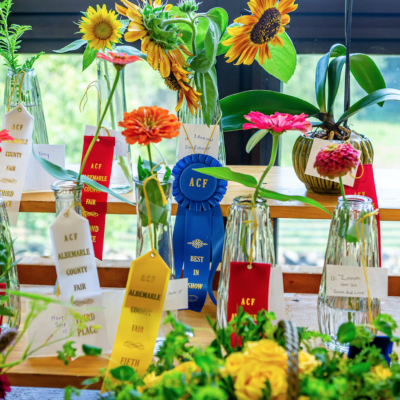“As wood grew scarce in England and France, laws were decreed limiting its use among commoners…In the mid-1600s, the British authorities decreed that Virginians who owned a hundred acres or more must build in brick.”—James Howard Kunstler, The Geography of Nowhere: The Rise and Decline of America’s Man-made Landscape
Kansas City, come to me
How one local couple designed their kitchen from afar
Several years ago, Stephen and Martha Stearns found themselves in Kansas City visiting Stephen’s elderly parents. Looking for a fun outing, and wanting to gather ideas for an upcoming renovation to their Charlottesville house, they headed out to a kitchen design store called Kleweno. “Remember in the movie Pretty Woman when she goes into the store and they treat her like ‘You couldn’t possibly afford this?’” says Martha. That’s exactly what the Kleweno saleswoman didn’t do. “She didn’t make us feel bad that we didn’t want the new Sub-Zero,” says Martha. “You never felt intimidated.”
 Is that a kitchen on your screen? Stephen and Martha Stearns weren’t afraid to go digital with their remodel. |
So enamored were the Stearnses of the service they received that they hired Kleweno to oversee their kitchen redo from half a continent away. The company twice sent representatives to the site—once to size up the existing kitchen and again later to install cabinets. Between visits, Kleweno and the Stearnses exchanged designs and ideas via email.
“We certainly paid them to come out here,” says Martha, but she nonetheless feels the finished kitchen—with black granite countertops, cherry cabinets and small copper accents—was worth some extra cost. The Stearnses hired local companies for other parts of the process: for example, the contractor who removed their old kitchen components.
There you have it: In today’s interconnected world, you may be able to work on feathering your nest even during your vacation—and if you really connect with a certain business, a faroff location doesn’t have to be a barrier. “I was mostly just sorry they don’t do bathrooms,” says Martha.—Erika Howsare
Furniture with a literary pedigree
Local artisan lets words speak to wood, and vice versa
In an age of over–specialization, John Casteen IV prefers to be the master of several trades. His company, Fern Hill Furniture Works in Earlysville, turns out lean, elegant pieces that are both functional and artistic. There is a fresh sophistication to the work, which combines Shenandoah Valley and Scandinavian styles. He describes the pieces as “traditional forms made of extraordinary materials.”
 They’re both crafts, after all: John Casteen IV fashions both furniture and literature in Earlysville. |
Meanwhile, Casteen’s first book of poems, Free Union, will be published in 2009 by the University of Georgia and The Virginia Quarterly Review, where he is on the editorial staff.
“The furniture, the writing, it is all part of the same package,” he explained. “The creative side of furniture-making feeds my writing.”
A graduate of the prestigious Iowa Writers’ Workshop, Casteen writes in several different forms—in addition to poetry, he writes political pieces about gun control and environmental policy. “Everything important in writing, observing things closely, paying attention to detail, transfers to making furniture, and vice versa. Each for me has always been a metaphor for the other.”
To see John Casteen’s furniture, check out www.johncasteen.com, or visit the Les Yeux du Monde gallery at 115 S. First Street.—Beth Herman
By the Numbers
20.6
(inches of rain we’ve gotten so far this year)
An arid May got us wondering: Are we in a drought? Actually, no: By mid-year, Charlottesville normally receives 21.8 inches of rain. Year to date for 2007, total precipitation was at 20.6 inches as we went to press.
Even though water is relatively plentiful this year, being proactive about conservation—especially with your lawn and garden—can‘t hurt.
Rainwater harvesting systems are one way to conserve, says Garnett Mellon, Easement and Education Programs Coordinator with the Thomas Jefferson Soil and Water Conservation District. To do this, simply install a rain barrel on your gutter to collect the water.
You may also want to think about xeriscaping, the water-conserving landscape design concept that all the cool kids are into. “The idea behind it is you plant species that are drought-tolerant so they don’t require a lot of water and don’t need a lot of irrigation,” she says. Drought-tolerant plants include cacti, yuccas, sedem, portulaca, and herbs like thyme and lavender.
Mellon also says adding two inches of mulch around plants helps water retention in the soil.
Another tip: Install a drip irrigation system instead of showering water on your plants from overhead. Water from on high will just evaporate in the heat, Mellon says, while the drip system trickles water directly on the root zone.—Jennifer Pullinger
Let’s play scribble
How to make any surface into a chalkboard
If your kids (or you, for that matter) can’t stop doodling on the walls, and you’re sick of scrubbing their masterworks off the satin-finish paint, devote a space to homegrown and temporary art by employing chalkboard paint. The stuff is made for virtually any surface, including wood, metal and plastic—even glass.
Buy chalkboard paint from any hardware or arts supply store. Then prep the surface as you would any other painting project. The final step is paint. Voila: instant canvas.
Benjamin Moore makes an acrylic-based chalkboard paint, while Rust-Oleum has a latex version. One quart is about $14. If you want the chalkboard to be magnetic too, simply slather the surface first with a magnetic paint undercoating. Or buy MagnaMagic’s two-in-one magnetic chalkboard paint. One quart covers 25 square feet and costs about $40.
Having your own in-house chalkboard allows you to write all of those things you were afraid to scribble on the Downtown Mall’s Free Speech Monument. Feeling like a censor? Removing the magnetic chalkboard altogether is also easy: Just sand it down and paint over it.—J.P.
Trouble tree
One of the most common invasive species in Virginia—visible along any roadway and, if you’re unlucky, your yard—is ailanthus, puzzlingly also called tree of heaven. Native to Asia, ailanthus propagates wildly and is alarmingly tough. We searched for an organic method of controlling ailanthus and came up short: cutting will not kill the plant and digging up the roots is nearly impossible for all but the youngest seedlings. Those unwilling to cut year after year apply herbicides to cut trunks in late summer; for more info, call the Virginia Cooperative Extension at 984-0727.





